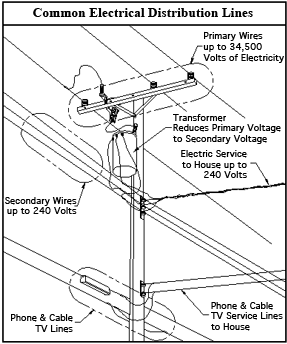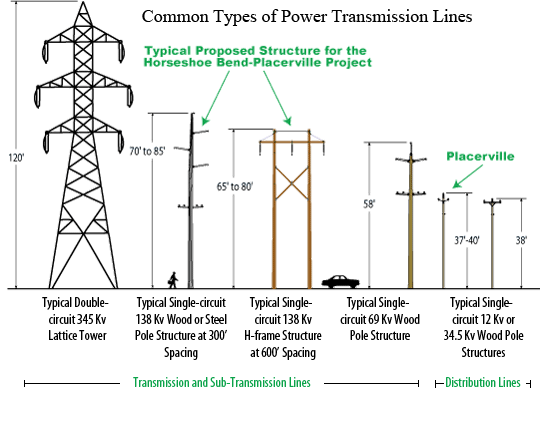Before assembly or disassembly of a crane, the employer must determine if it could come within 20 feet of a power line (up to 350 kV). If so, the employer must take one of the following actions:
(a) Confirm with the power company that the line is de-energized and visibly grounded at the worksite.
(b) Make sure no part gets within 20 feet of the power line.
(c) Follow Table A, which has minimum clearance distances based on voltage.
TABLE A: MINIMUM CLEARANCE DISTANCES BASED ON VOLTAGE
| Voltage | Minimum clearance distance |
|---|---|
| Up to 50 kV | 10 ft* |
| >50 to 200 kV | 15 ft* |
| >200 to 350 kV | 20 ft* |
| >350 to 500 kV | 25 ft* |
| >500 to 750 kV | 35 ft* |
| >750 to 1,000 kV | 45 ft* |
| >1,000 kV | Determined by the utility / owner |
*According to 1926.1409, for power lines over 350 to 1,000 kV, the minimum distance is presumed to be 50 feet. Over 1,000 kV, the utility/owner or a registered engineer must establish it.
Cranes cannot be assembled/disassembled below an energized power line or within the Table A clearances from a power line. If Table A is used, the owner/utility must provide the power line voltage to the employer within two days of a request.
Power lines must be assumed to be energized until they are confirmed to be de-energized and visibly grounded. Warnings about electrocution hazards must be posted conspicuously in the crane cab and outside the cab in view of the operator (except for overhead gantry and tower cranes).
The work zones must be demarcated 360 degrees around the equipment to prevent encroachments within 20 feet of a power line. If the line is not de-energized, a meeting must also be held with the crew before operations begin to review the location of the lines and procedures to prevent encroachment. Measures similar to those required during assembly/disassembly must be taken to prevent encroachment, but in this case an insulating link between the load line and the load is also an option.
Operators and crew members must be trained:
- On the procedures to follow in the event of power line contact
- To presume that power lines are energized until confirmed and visibly grounded
- To presume that power lines are not insulated until otherwise confirmed by the owner or a qualified person
- On the limits of insulating links and other devices (e.g. proximity alarms)
- On proper grounding procedures and their limitations.
Spotters must also get applicable training.

What if the Line is Not De-energized?
If the line is not de-energized, the employer must take the following actions:
- Conduct a meeting with the assembly/disassembly crew to review measures to prevent encroachment.
- Use only nonconductive tag lines.
- Use a dedicated spotter, a proximity alarm, a range control warning device, an automatic limit device or an elevated warning line/barrier placed in view of the crane operator.
EXCEPTIONS TO TABLE A? FOLLOW THESE MINIMUM PRECAUTIONS
If work must operate closer than the Table A values, then the following precautions must be taken at a minimum:
- The employer must show that Table A is infeasible and that it is infeasible to de-energize and ground or relocate the line.
- Safe distances must be determined by the owner/operator of the line or a registered professional engineer who is a qualified person.
- A planning meeting must be held and procedures developed must be implemented (if procedures are inadequate, work must be stopped and new procedures established or the line must be de-energized).
- Automatic re-energizing devices must be inoperative.
- A dedicated spotter must be assigned.
- An elevated warning line/barricade or an insulating link must be installed between the line and the load, except for work on electrical transmission/distribution lines covered by Subpart V (additional provisions take effect one to three years after the effective date).
- Non-conductive rigging must be used.
- A range-of-motion limiting device must be used.
- Non-conductive tag lines must be used.
- Barricades at least 10 feet from the equipment (where feasible) must be established.
- Equipment must be properly grounded.
- Workers must be kept from touching the line above the insulating link.
- Only essential personnel are allowed in the area.
- Insulating line hose or cover up must be installed by the owner/operator unless unavailable.
- The owner and user must meet with the equipment operator and other workers to review procedures.
- One person must be identified who will implement the plan and can stop work if necessary.
- Documentation of these procedures must be immediately available on site.
- Safety devices and aids must comply with manufacturers’ specifications.
- All employees must be trained in power line safety per 1926.1408 (g).

Equipment Clearance Distances
Equipment traveling under or near a power line must:
(a) Have a lowered boom/mast and support system
(b) Obey minimum clearance distances set in Table T
(c) Reduce speeds to minimize breaching
(d) Use a dedicated spotter if closer than 20 feet
(e) Illuminate or identify the power lines at night
(f) Identify and use a safe path of travel.
Table T
Minimum clearance distances while traveling with no load
| Voltage | Minimum clearance distance |
|---|---|
| Up to 0.75 kV | 4 ft |
| >0.75 to50 kV | 6 ft |
| >50 to 345 kV | 10 ft |
| >345 to 750 kV | 16 ft |
| >750 to 1,000 kV | 20 ft |
| >1,000 kV | * |
| >1,000 kV | Determined by the utility / owner |
*Established by owner or registered professional engineer/qualified person.






